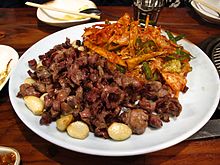Dak-ttongjip
This article may require copy editing for grammar, style, cohesion, tone, or spelling. (May 2017) |
 | |
| Place of origin | South Korea |
|---|---|
| Region or state | Daegu |
| Associated cuisine | Korean cuisine |
| Invented | 1972 |
| Serving temperature | Warm |
| Main ingredients | Chicken gizzards |
| Korean name | |
| Hangul | 닭똥집 |
|---|---|
| Revised Romanization | dak-ttongjip |
| McCune–Reischauer | tak-ttongtchip |
| IPA | [tak̚.t͈oŋ.t͈ɕip̚] |
Dak-ttongjip (닭똥집), literally "chicken gizzard", is a Korean dish made by stir-frying chicken gizzard prepared with spices.[1] It is a popular anju (accompaniment to alcoholic drinks).[2]
Etymology and translations
Dak-ttongjip (닭똥집) is a vernacular term for "chicken gizzard", with its components dak (닭) meaning "chicken", and ttongjip (똥집) normally meaning "big intestine" or "stomach".[1][3][4] However, as ttong and jip can be (mistakenly) parsed as "poo" and "house" respectively, mistranslations such as "chicken poo house" or "chicken asshole house" are not uncommon.[2][5]
History
In 1972, dak-ttongjip was a giveaway side dish for day laborers visiting Sama Tongdak, a fried chicken restaurant at Pyeonghwa Market in Daegu.[6] Due to the rousing reception, it became a regular menu item. Soon, it became the most popular food at Pyeonghwa Market, where there is a "dak-ttongjip alley" today.[6] Dak-ttongjip is now considered the local specialty of Daegu.[6]
References
- ^ a b "dak-ttongjip" 닭똥집. Standard Korean Language Dictionary (in Korean). National Institute of Korean Language. Retrieved 19 February 2017.
- ^ a b Montgomery, Charles (15 May 2014). "The 10 Most Bizarre Korean Foods To Try Out". 10 Magazine. Retrieved 13 May 2017.
- ^ "dak" 닭. Standard Korean Language Dictionary (in Korean). National Institute of Korean Language. Retrieved 13 May 2017.
- ^ "ttongjip" 똥집. Standard Korean Language Dictionary (in Korean). National Institute of Korean Language. Retrieved 13 May 2017.
- ^ Ko, Dong-hwan (14 July 2016). "Authorities fry hard to fix Korean menus lost in translation". The Korea Times. Retrieved 13 May 2017.
- ^ a b c Kim, Hyun-min (25 July 2015). "In Daegu, revered chickens, fried gizzards and beer". Korea JoongAng Daily. Retrieved 13 May 2017.
